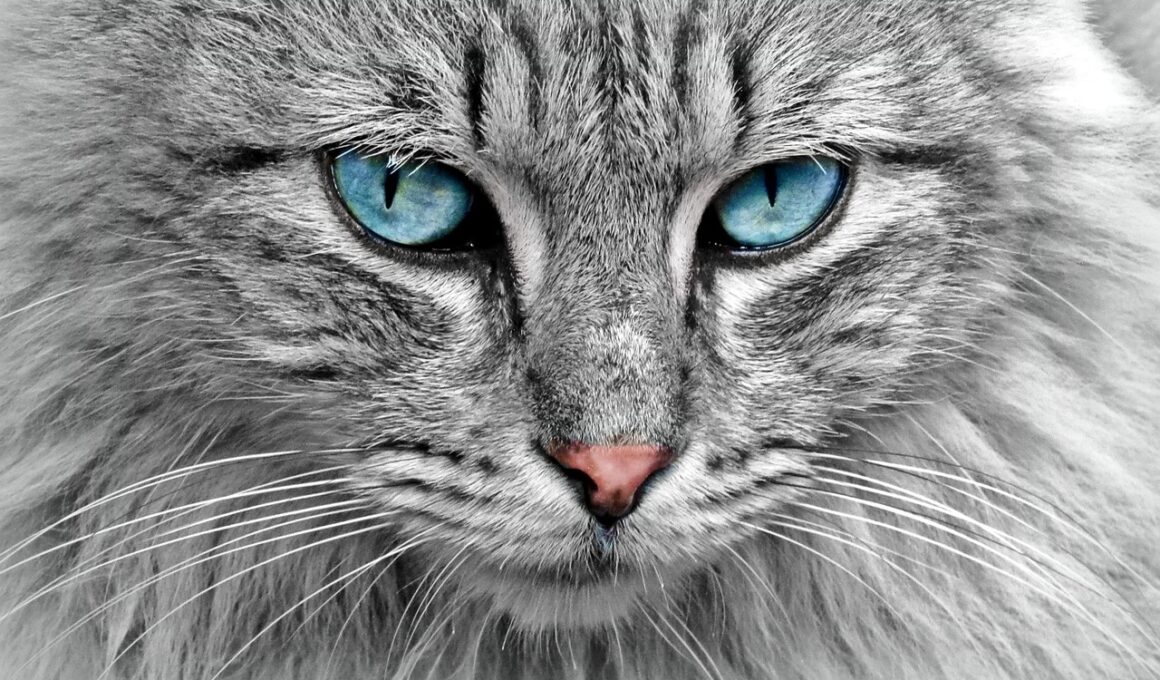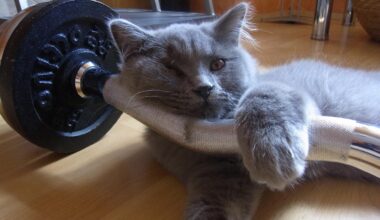How Technology Enhances Cat Feeding Training Routines
Cat training often includes the essential task of getting pets to use automatic feeders. These devices have revolutionized feeding routines and can be particularly advantageous for busy pet owners. Automatic feeders can dispense predefined portions at scheduled times, ensuring your cat receives the right amount of food consistently. Training a cat to use these feeders requires patience and a step-by-step approach. Initially, it’s essential to familiarize your cat with the device and its sounds. Placing their favorite food inside can help entice them. Over time, a cat will learn that the feeder provides food. Associating the sound of the feeder with mealtime can create a positive experience for your furry friend. Understanding how this technology works in sync with your cat’s natural behaviors can enhance the training process significantly. It allows pet owners to balance their lifestyles while ensuring their pet remains well-fed. The benefits of using such feeders extend beyond convenience; they can also help manage weight and monitor feeding habits, which is crucial for your cat’s health. Thus, investing in automatic feeders may simplify your training efforts.
Once your cat associates the automatic feeder with mealtime, it becomes essential to establish a routine. Consistency is key when training your cat to use this technology effectively. Begin by setting a regular feeding schedule which your cat can learn to anticipate. Cats thrive on routines, and having set times for meals can encourage them to approach the feeder when it’s time to eat. Adjusting the feeder to dispense small amounts frequently can also keep your cat engaged and interested. Gradually increasing the portions and the time between feedings helps your cat adapt without feeling deprived. Monitor your cat’s reaction to the schedule, ensuring they aren’t stressed or overly eager. Consider incorporating rewards like petting or playtime to reinforce positive behavior associated with using the feeder. This approach not only encourages your cat to follow the schedule but also builds trust between you both. You can further enhance your training routine by observing your cat’s unique behavior. Every cat is different, and some might take longer to adapt than others. Patience, along with positive reinforcement, is critical during this training period.
Using an automatic feeder doesn’t just change the feeding routine; it also opens opportunities for enriching your cat’s daily life. Many feeders come equipped with features like programmable meal times, portion control, and even remote access through apps. These technological innovations are designed to support pet parents in managing their pets’ nutrition better. Some modern feeders allow you to record your voice, letting your cat hear your voice at mealtime. This familiar sound can further reassure your cat, making them feel connected to you. When introducing the app features, guide your cat through the experience, associating the smartphone notifications with food delivery. You can synchronize your own meal times with your cat’s, creating a shared experience. Engaging with tech allows you to monitor your cat’s eating habits and health. Keeping track of portions dispensed over time can give you insight into your cat’s dietary needs. If any issues arise, it becomes easy to address them quickly. Cats benefit immensely from the structure and routine that arise from scheduled feeding, impacting their overall health positively.
Monitoring Health Through Automatic Feeders
Health monitoring is another crucial aspect of using automatic feeders for training your cat. Many smart feeders come with apps that track your pet’s feeding patterns. Such tracking can help you detect any unusual changes in their eating habits, which may indicate health concerns. For instance, if your cat suddenly starts eating less, this could be a sign of illness that requires immediate attention. Conversely, if your cat appears to overeat, it may indicate emotional stress or other issues. A stable routine enables you to gauge the overall well-being of your pet effectively. By combining technology with regular vet visits, you can ensure your creditability maintains good health. Some feeding devices even allow specific dietary preferences, which can help in catering to specialized food requirements based on medical needs. This kind of adaptability in feeding routines can significantly affect your cat’s quality of life. Additionally, utilizing automatic feeders efficiently can minimize waste, as you’ll have better control over portion sizes. Understanding the correlation between feeding behaviors and overall health furthers the importance of adopting these technological solutions.
Integrating technology into cat feeding training enhances the relationship between you and your feline friend. As your cat becomes accustomed to automatic feeders, you’re likely to spend less time managing mealtimes and more quality time bonding with them. Building a routine with your cat can be an enjoyable experience for both parties involved. Play can be seamlessly integrated into this routine, providing fun as you train your pet on how to interact with their new feeder. Additionally, since many automatic feeders offer innovative features, you can customize settings that suit your pet’s diet. Virtual feeding can also save you time when you need to leave home for work or travel. Knowing your cat is well-fed while you are away brings peace of mind. Furthermore, smart technology can aid in reducing stress levels in your pets. By adhering to a regular schedule, your feline can learn when to expect meals, minimizing anxiety associated with uncertain feeding times. This predictability adds comfort, letting you both enjoy a harmonious living arrangement.
Furthermore, adapting to an automatic feeder requires observation. Every cat responds differently to technological changes. Some might take to the feeder instantly, while others may be initially hesitant. Observing your cat’s behavior during feeding times helps you refine the training process. If your cat is not engaging with the feeder, you may want to consider alternative strategies such as using their favorite type of food to entice them or placing toys near the device to generate curiosity. This interaction can lead to a more beneficial training experience, strengthening their willingness to engage. Additionally, consider including the feeder as part of interactive playtime. Incorporating puzzles or other mentally stimulating activities with feeding can provide an enriching experience for your cat. Active engagement can develop their problem-solving skills while reducing boredom. Ensuring your cat views the feeder as a positive addition to their routine also enhances acceptance. This acceptance is crucial for success in training your cat to adapt to their automatic feeding schedule, ultimately benefiting both you and your pet.
Conclusion: Embracing Technological Advances for Feline Health
In conclusion, embracing technological innovations in training cats to use automatic feeders opens a world of possibilities for pet owners and their feline companions. The intersection of technology and pet care significantly enhances the convenience of managing feeding routines while contributing positively to your cat’s overall health. Understanding how to effectively train your cat to use an automatic feeder will empower you to keep them well-nourished. The combination of habitual feeding schedules, health monitoring, behavioral observations, and playful engagement creates a comprehensive framework for enriching your cat’s life. As pets become accustomed to these devices, they thrive through structured routines and receive proper nutrition catered to their individual needs. Properly integrating automatic feeders helps to maintain a happier, healthier, and more balanced lifestyle for both you and your pet. The importance of proactive feeding solutions cannot be overstated, as they play a pivotal role in managing feline health. Consequently, investing in automatic feeders is not merely about convenience; it’s about ensuring your beloved pet’s well-being for years to come.
Each day presents an opportunity for further optimization of feeding experiences for your cat. Leveraging automatic feeders offers endless potential for enhancing not only feeding routines but also enriching your cat’s daily life. Where conventional methods limit interaction, technology paves the way for innovative solutions tailored to every unique feline personality. Beyond mere feeding, the implications of such technology underscore the importance of technology in pet care. Additionally, evaluating the benefits of such shifts continuously will lead to refining the training process, ensuring maximum effectiveness. Understanding your pet’s behavior within the context of technological advancements can reveal insights. These insights can become beneficial for long-term care strategies aimed at promoting comprehensive health and wellness for your cat. Given the intersections between behavior, nutrition, and technology, pet owners can effectively harness these elements into a cohesive care routine. The integration of automatic feeders symbolizes the future of cat care. It’s not just a tool; it’s a way to foster a deeper connection between owners and pets through shared experiences. In doing so, we ultimately enhance the bond that is vital for a fulfilling companionship.


